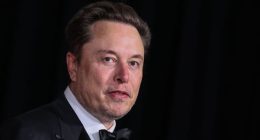
Kharkiv, Ukraine — Russian President Vladimir Putin has ordered military operations in Ukraine, promising aggression against the eastern European country in defiance of Ukrainian pleas for peace and U.S. promises of economic consequences.
Shortly after Putin’s speech, multiple reporters on the ground are reporting large explosions in Kyiv, Ukraine’s capital. CNN reporter Matthew Chance heard the explosions first on live television. Explosions are also being heard here in Kharkiv, a city of more than 1 million people in eastern Ukraine. In both cities, the source or sources of the explosions remains unknown.
The declaration follows a last-ditch plea from Ukrainian President Volodomyr Zelensky to avert war. In a televised address, Zelensky spoke in Russia as he said his country and its people want peace, adding he had attempted to call Putin on Wednesday but the Russian leader had not answered.
The week preceding the invasion saw a build-up both military activity and of the Russian propaganda effort to justify the invasion. Violence escalated in the region on Saturday, with increased shelling and calls to arms from pro-Russian leaders in both of eastern Ukraine’s separatist territories. Ukraine’s defense minister on Saturday said the shelling had killed two of his country’s soldiers and wounded five others, The Washington Post reports.
On Monday, Putin recognized the separatist territories — Donetsk and Luhansk — as independent. The move was a transparent attempt to justify moving Russian troops into the territories, aiming to portray Russian troops as liberators and existing Ukrainian troops in the area as illegitimate. Last week, the Kremlin and affiliated news sources pushed a narrative of Ukrainian aggression on Russian and pro-Russia forces. Those claims were based on outright fictions or distortions of isolated incidents, Rolling Stone reported.
The United States and its western allies, who worked preemptively to arm Ukraine for self-defense, are working to impose economic penalties on Russia for the invasion. The first wave of sanctions started on Tuesday, with the measures aimed at Russia’s sovereign debt and the nation’s wealthy elite. In conjunction with Germany, the U.S. also froze construction of the Nord Stream 2 pipeline, which would have given Russia’s natural gas producers better access to European markets.
The Biden administration is warning of further penalties for Russia should its troops move farther into Ukraine. “We will impose far-reaching financial sanctions and export controls. We will target Russia’s financial institutions and key industries. And we will target those who are complicit and those who aid and abet this unprovoked invasion,” Vice President Kamala Harris said earlier this month at the Munich Security Conference in Germany.
The roots of the current crisis in Ukraine are varied and complex, but at their center is the question of Ukraine’s place in the European “security paradigm,” both militarily, as a prospective member of NATO, and economically, as a prospective partner with the European Union. Negotiations over the country’s status have increasingly been framed as a two-sided battle between Biden and Putin, but there are many other factors at play.
But as the lines on the map move from side to side, the consequences will be felt most acutely by the people living near the fighting.
Since 2014, more than 14,000 people, including 3,300 civilians, have died in the conflict, according to the United Nations. The fighting has also displaced an estimated 1.4 million people who have fled their homes or moved elsewhere to escape danger along the front lines. U.S. officials have predicted that a new Russian invasion would be drastically more devastating, and could cause up to 50,000 civilian casualties and displace up to 5 million people from their homes in a matter of days.
These people are not abstractions: They are Anatoliy and Svetlana in the village of Pisky, a married couple of 46 years whose garage bears the reminder: “PEOPLE LIVE HERE. AND CAT MURKO.” They are Irina and Vitaliy in Adviika, cafe owners in a war-torn who days before the invasion were still hoping for peace in a town that has had far too little of it.
But after a long, ominous buildup, open war is here again. Russia has been amassing troops at the Ukrainian border for months, and the invasion follows a several-day stretch in which U.S. officials warned war was imminent. President Biden told reporters on Thursday that there is “every indication” Russia was about to strike, and that he believed an invasion was coming “in the next several days.”
The United States has provided economic and military aid to Ukraine. There is no indication, however, that the United States military would intervene directly in Ukraine, a move that would set off an overt military conflict between two nuclear-armed nations. Putin on Saturday launched nuclear exercises, a reminder to would-be interventionists of Russia’s massive military capability.
Russia and Ukraine have been in a protracted, largely frozen conflict since 2014, when the Russian government annexed Crimea, taking over the peninsula’s valuable ports on the Black Sea. Russia then supported domestic unrest in Ukraine’s eastern Donbas region, which spiraled into a shooting war when Russia-backed separatist forces seized territory in the region. The separatists declared two semi-autonomous republics in the Donetsk and Luhansk subregions of Donbas, fighting bitterly with Ukrainian forces for more than a year following the annexation of Crimea. Both sides dug in and the border remained mostly stable for seven years.
Zelensky promised to deal directly with Russia and make a deal to end the war during his successful 2019 campaign, but some of his actions — particularly the shutdown of pro-Russia TV oligarch Viktor Medvechuk’s TV networks in the Ukraine — soured negotiations between the two countries.
Russia began building up its military forces close to Ukraine’s border in the spring of 2021, but drew them back slightly as the year progressed. By December, however, Putin began transferring units back toward the border, and through January massively increased this buildup, announcing military exercises with neighboring Belarus and dramatically increasing their troop presence there. Russia’s combined forces in preparation for the invasion were estimated at well over 100,000 troops. The Belarus exercises meant Ukraine was encircled by Russian forces on three sides, and by January U.S. officials were warning that an invasion was imminent.
Source: RollingStone





